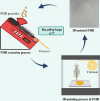Recycling and 3D-Printing Biodegradable Membranes for Gas Separation-toward a Membrane Circular Economy
- PMID: 38962722
- PMCID: PMC11217943
- DOI: 10.1021/acsaenm.4c00060
Recycling and 3D-Printing Biodegradable Membranes for Gas Separation-toward a Membrane Circular Economy
Abstract
Polymer membranes employed in gas separation play a pivotal role in advancing environmental sustainability, energy production, and gas purification technologies. Despite their significance, the current design and manufacturing of these membranes lack cradle-to-cradle approaches, contributing to plastic waste pollution. This study explores emerging solutions, including the use of biodegradable biopolymers such as polyhydroxybutyrate (PHB) and membrane recycling, with a focus on the specific impact of mechanical recycling on the performance of biodegradable gas separation membranes. This research represents the first systematic exploration of recycling biodegradable membranes for gas separation. Demonstrating that PHB membranes can be recycled and remanufactured without solvents using hot-melt extrusion and 3D printing, the research highlights PHB's promising performance in developing more sustainable CO2 separations, despite an increase in gas permeability with successive recycling steps due to reduced polymer molecular weight. The study emphasizes the excellent thermal, chemical, and mechanical stability of PHB membranes, albeit with a marginal reduction in gas selectivity upon recycling. However, limitations in PHB's molecular weight affecting extrudability and processability restrict the recycling to three cycles. Anticipating that this study will serve as a foundational exploration, we foresee more sophisticated recycling studies for gas separation membranes, paving the way for a circular economy in future membrane technologies.
© 2024 The Authors. Published by American Chemical Society.
Conflict of interest statement
The authors declare no competing financial interest.
Figures









Similar articles
-
The Minderoo-Monaco Commission on Plastics and Human Health.Ann Glob Health. 2023 Mar 21;89(1):23. doi: 10.5334/aogh.4056. eCollection 2023. Ann Glob Health. 2023. PMID: 36969097 Free PMC article. Review.
-
Advancing Plastic Recycling: Challenges and Opportunities in the Integration of 3D Printing and Distributed Recycling for a Circular Economy.Polymers (Basel). 2023 Sep 25;15(19):3881. doi: 10.3390/polym15193881. Polymers (Basel). 2023. PMID: 37835930 Free PMC article. Review.
-
Recycling Technologies for Biopolymers: Current Challenges and Future Directions.Polymers (Basel). 2024 Sep 30;16(19):2770. doi: 10.3390/polym16192770. Polymers (Basel). 2024. PMID: 39408479 Free PMC article. Review.
-
Net zero on 3D printing filament recycling: A sustainable analysis.Sci Total Environ. 2023 Oct 10;894:165046. doi: 10.1016/j.scitotenv.2023.165046. Epub 2023 Jun 22. Sci Total Environ. 2023. PMID: 37355139 Review.
-
Waste to wonder to explore possibilities with recycled materials in 3D printing.Sci Total Environ. 2023 Dec 20;905:167109. doi: 10.1016/j.scitotenv.2023.167109. Epub 2023 Sep 16. Sci Total Environ. 2023. PMID: 37717760
Cited by
-
Modelling Across Multiple Scales to Design Biopolymer Membranes for Sustainable Gas Separations: 2-Multiscale Approach.Polymers (Basel). 2024 Sep 30;16(19):2776. doi: 10.3390/polym16192776. Polymers (Basel). 2024. PMID: 39408485 Free PMC article.
References
-
- Bernardo P.; Drioli E.; Golemme G. Membrane Gas Separation: A Review/State of the Art. Ind. Eng. Chem. Res. 2009, 48 (10), 4638–4663. 10.1021/ie8019032. - DOI
-
- Pandey P.; Chauhan R. S. Membranes for Gas Separation. Prog. Polym. Sci. 2001, 26 (6), 853–893. 10.1016/S0079-6700(01)00009-0. - DOI
-
- Sidhikku Kandath Valappil R.; Ghasem N.; Al-Marzouqi M. Current and Future Trends in Polymer Membrane-Based Gas Separation Technology: A Comprehensive Review. J. Ind. Eng. Chem. 2021, 98, 103–129. 10.1016/j.jiec.2021.03.030. - DOI
-
- Siagian U. W. R.; Raksajati A.; Himma N. F.; Khoiruddin K.; Wenten I. G. Membrane-Based Carbon Capture Technologies: Membrane Gas Separation vs. Membrane Contactor. J. Nat. Gas Sci. Eng. 2019, 67, 172–195. 10.1016/j.jngse.2019.04.008. - DOI
-
- Scholes C. A.; Stevens G. W.; Kentish S. E. Membrane Gas Separation Applications in Natural Gas Processing. Fuel 2012, 96, 15–28. 10.1016/j.fuel.2011.12.074. - DOI
LinkOut - more resources
Full Text Sources
